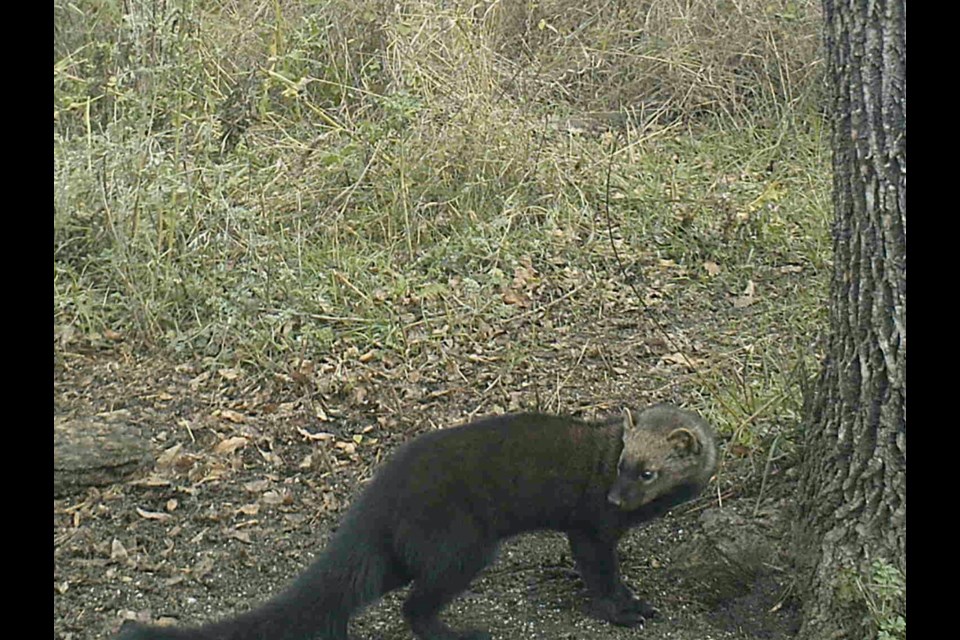ESTEVAN — A fisher recently showed up southwest of Estevan. The animal was first caught on Garry Leslie's trail camera on Oct. 6, and since then made numerous appearances.
The fisher is a small carnivorous mammal native to North America, and while Saskatchewan is its habitat, it's not spotted in the southeast very often. Don Gordon, the president of the Saskatchewan Trappers' Association, said fishers are not known to be as far south as Estevan in Saskatchewan, but being a natural predator and scavenger, any food source will force them to travel.
"There have been numerous fishers caught north of Estevan in the Yorkton area and as far south as the Moose Mountain [Provincial] Park, so travelling this far is entirely possible," Gordon said.
Fishers also can be found throughout eastern Canada, southern Alberta and in the Rocky Mountains, and as far south as California and in the Appalachian Mountains in the U.S.
Gordon noted if the animal was spotted in the area several times, there is a good chance that it made this area its home.
"Logging plays a big role in their habitat. They are scavengers so they'll keep on moving. But an animal like that, they set up territory if there's food and shelter," Gordon said.
"By the looks of it, it's a good-sized one, so it's probably a male because there is a very, very big difference in the male and female ... The biggest male [fisher] I've ever caught was, I think, 14 1/2 pounds. But a female will be seven to eight pounds. So, weight-wise, probably half. So, if there's one there that might be more.
"And if it is just one animal that is kind of touring around, probably being a male, he'll be looking for females. This is a breeding season. They're always on the move, but they're the type of animal that when they find a good food source, they're going to stick around."
Gordon noted that while fishers are mostly found in the forests, river banks also work fine. A fisher might also be moving in since there might be more food available and a lack of natural predators that hunt them.
"Right now, there's more rabbits on the landscape, lots of birds, so they've got lots of food. The only [thing] that might make it disappear is if it's travelling for a mate," Gordon said. "But those river breaks, that type of forest, is a natural setting for them also. Their biggest fear would be a predator from above, something like an eagle – the fisher is about the size of a fox with little short legs. So, unless somebody sees it or catches it in a trap, it most likely will hang around."
Fisher is a member of the weasel family and is closely related to but larger than the American marten. This forest-dwelling creature's range covers much of the boreal forest in Canada to the northern United States.
In many areas, fishers have been successfully reintroduced after being heavily trapped for their fur in the past.
"They are a great animal. Back in the day, they used to be a very valuable animal for their fur. Now not so much, but they are still used as trim garments. Very beautiful fur. If you ever have an opportunity to see those animals, have a look at what we have to offer in this province," Gordon said.
Fisher habitat consists of mixed or coniferous forests with a lot of tree cover and hollow trees or logs for dens.
Mainly carnivores, fishers prey mostly on small mammals like mice, squirrels, voles and shrews, but they will also hunt larger mammals and are skilled at killing porcupines by attacking the quill-free face repeatedly until the porcupine is too injured to defend itself. They also eat fruits, berries, nuts and insects.
"They prey on small game such as rabbits as well as game birds like grouse, pheasant and partridge," Gordon said. "They will also scavenge on dead animals found, like roadkill deer or dead livestock around farming operations."
Fishers are also known for getting into farmyards and going after smaller domestic animals.
"I have had numerous people tell me that they have had cats disappear around the farm only to find out a fisher was in the area and was the predator," Gordon said, noting they also may get into chickens and other domestic animals and, like weasels, they can get through pretty small holes.
Despite their name, fishers eat very little fish if any at all. The name came from European settlers, as they believed these animals resembled European polecats – "fiche" in old English and "fissau" in old French, which eventually turned into "fitchet" among the early settlers and fur traders, mistakenly adapted into the English word "fisher", according to Shubenacadie Wildlife Park website.
Fishers can swim but prefer to be up in the trees. They are fast and agile hunters on the ground and in trees. Their hind feet can rotate almost 180 degrees, enabling them to climb down trees headfirst.
To mark their territory and deter predators, they emit a smelly musk, like all members of the weasel family.
the weasel family.




